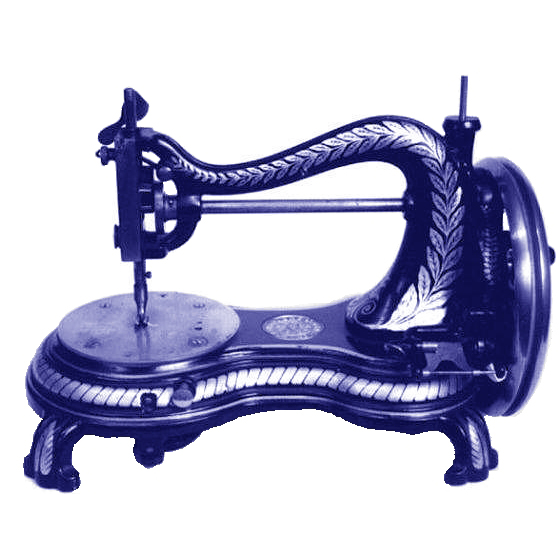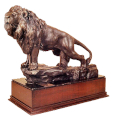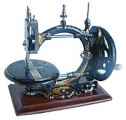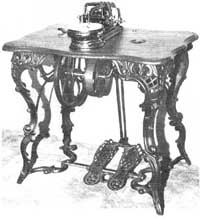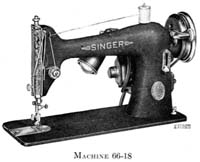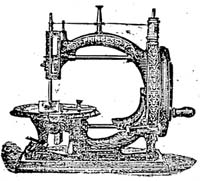Collecting by Default; Why Beryl has Alan in Stitches.
Shortly after ISMACS members received the last magazine (#80), I received an envelope in the mail from Alan Heaudebourck-Burford of the UK. In it was the short story below, a personal note from him, and an original newspaper clipping from "The Post" dated June 1982. We have reprinted the article and accompanying photo in its entirety and hope you enjoy it as much as we did.
I did not intentionally start collecting, but rather I inherited a collection and carried it on. It all began one day in 1970 when my wife, Beryl, was in an Oxfam resale shop. They had small sewing machine, a Muller by Clemens, for sale and since they only asked 25 pence, she bought it. The sewing machine she purchased was to be a decorative display piece for her home salon. At the time, Beryl had a shop in our home where she was a private couture for many well-to-do ladies. She also taught fashion design and sewing machine basics at the local college and planned to use the machine as a teaching tool.
Not long after the Muller came home, was cleaned up, and put on view, one of Beryl's clients commented that she had an "old" sewing machine and wondered if Beryl would like to have it to add to the display. Naturally, Beryl agreed and shortly thereafter, the second machine accompanied the first.
As word got out that Beryl had a collection of "old" sewing machines, we began to acquire them from an assortment of contributors; some machines were free for the taking and others were purchased. As it became known in my office that my wife collected sewing machines, they started to arrive from building sites all over Britain. In the mean time, Beryl and I began to peruse local church sales, jumble sales, and auctions. It was one of these auctions that we met Maggie Snell for the first time, and found out about ISMACS. Before long, the number of machines in our collection reached 140. It was my job to clean the machines and care for the cases while Beryl made the machines sew.
Sadly, Beryl became ill and died of a brain tumor leaving me with the collection. After that, I attended several conventions, and continued to give talks to local societies about the history of the sewing machine; my enthusiasm was not as keen as before. However, enthusiasm or not, machines still arrived at my house. Later, due to various circumstances, I had to move. My new home is considerably smaller and is unable to accommodate such a large collection; so just prior to the move, I liquidated approximately 50% of the collection. In due time, I am planning to further reduce the collection, however I am not sure how and when this will happen.
Reprinted from The Post, June 1982Why Beryl has Alan in stitches
By Post Reporter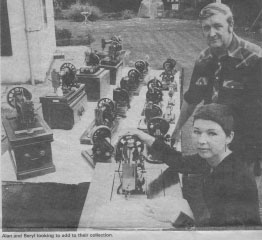
Beryl and Alan with their sewing machine collection
ALAN BURFORD never worries if a shirt button needs sewing on…he just gives it to his wife Beryl to do on the sewing machine. Well, one of the Burford's sewing machines. They have more than 40! "And what's more they are all in working order," said Alan, senior purchasing manager at Bovis Construction's Harrow office.
But despite having what Alan thinks might be the largest private collection of antique sewing machines in the country, he is still looking for more.
"It all started four or five years ago," he told 'The Post'. "Beryl was in an Oxfam shop when she spotted a kiddies sewing machine which they were selling for 25 pence. She bought it and we've just bought more and more."
Since that time the machines have started taking over the Burford's home in Hatch End, Middlesex.
"The house creaks with them, the garden shed groans with them and you can't get in the garage at all. That's so packed we have to leave the cat outside," said Alan. He and Beryl travel hundreds of miles in search for more antique machines to add to the collection. They follow up tip-offs from friends and relatives around the country.
"If we had to go all the way to Scotland we would, providing we thought the machine was worth it."
The oldest machine in their collection is dated 1860, and it's mainly 19th century models they are after, or one-offs like their prized Vickers model (Vickers are better known for their armaments).
"Beryl is a qualified dressmaker and knows everything there is to know about sewing," said Alan. "She even lectures on the subject."
"We are offered a lot of Singers, but unless they are in particularly good condition they are not usually worth bothering with. There were over 10 million made before the turn of the century."
Many of the machines the Burfords have bought have needed extensive renovation. Alan looks after the wood-work while Beryl strips down the machinery and overhauls it.
"Some machines are in a terrible condition when we pick them up," added Alan. "Especially the cabinets — they take the hardest bashing. But with time and a lot of patience they can usually be restored." Alan says he has paid £40-£50 for a machine, "although we turned down one which was offered by an antique dealer who wanted £110.
As well as the sewing machines the 'Burfords also have five treadle machines. A much rarer commodity which takes up hardly any space are the old instruction books on how to operate and service the machines. "They are becoming collectors items," he said. So what do the Burford's neighbours think of the collection?
"They are very helpful," said Alan, some may think it a little strange but most are like our own son, intrigued."
''At least I never leave the house without a button missing!"
